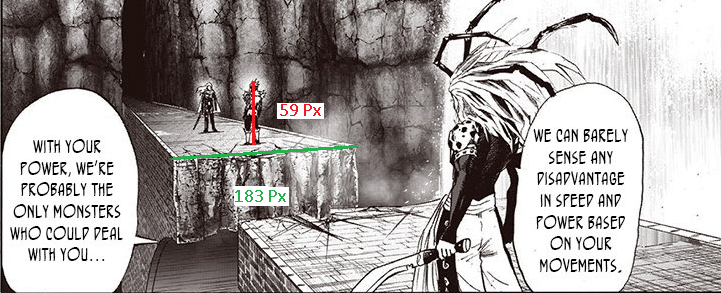I left an evaluation, Sage and EOW calcs seem good but I have a problem with the height used in the ocean split calc.
Navigation
Install the app
How to install the app on iOS
Follow along with the video below to see how to install our site as a web app on your home screen.
Note: This feature may not be available in some browsers.
More options
-
This forum is strictly intended to be used by members of the VS Battles wiki. Please only register if you have an autoconfirmed account there, as otherwise your registration will be rejected. If you have already registered once, do not do so again, and contact Antvasima if you encounter any problems.
For instructions regarding the exact procedure to sign up to this forum, please click here. -
We need Patreon donations for this forum to have all of its running costs financially secured.
Community members who help us out will receive badges that give them several different benefits, including the removal of all advertisements in this forum, but donations from non-members are also extremely appreciated.
Please click here for further information, or here to directly visit our Patreon donations page. -
Please click here for information about a large petition to help children in need.
You are using an out of date browser. It may not display this or other websites correctly.
You should upgrade or use an alternative browser.
You should upgrade or use an alternative browser.
VS Battles Wiki Forum
View previous comments…
Therefir
NikHelton
I understand what is confusing you, but the more I look at the boundary of the wave and the ocean, the more I see that it is actually very deep. Maybe in this case we should calculate the mass of each wave?
I mean, we already have their height and width. Just find their KE and add them up.
I mean, we already have their height and width. Just find their KE and add them up.
NikHelton
Wave height = 471 pixels = 122,004 m;
Width = 396 pixels = 102,576 m;
Since the wave has the shape of a spiral, I will use 70% of the void.
V = 122 004 * 102 576 * 44672548 = 5,5906275 × 10^17 m^3;
Density = 1020 kg/m^3;
Weight = 5,5906275 × 10^17 * 1020 * 0,3 ( considering the void) = 1.710732 × 10^20 kg;
KE = 1,710732 × 10^20 * 27846 * 27846/2 = 6,6325055 × 10^28 joules;
We have 2 waves, so we multiply the result by 2.
E = 6,6325055 × 10^28 * 2 = 1,3265011 × 10^29 joules = 31.7 exatons = 5-C;
This is the mid end
High end = 1,710732 × 10^20 * 55692 * 55692 = 5,3060044 × 10^29 joules = 126 exatons = 5-C;
I did not divide the energy by 2 since we will still multiply by 2 waves.

Width = 396 pixels = 102,576 m;
Since the wave has the shape of a spiral, I will use 70% of the void.
V = 122 004 * 102 576 * 44672548 = 5,5906275 × 10^17 m^3;
Density = 1020 kg/m^3;
Weight = 5,5906275 × 10^17 * 1020 * 0,3 ( considering the void) = 1.710732 × 10^20 kg;
KE = 1,710732 × 10^20 * 27846 * 27846/2 = 6,6325055 × 10^28 joules;
We have 2 waves, so we multiply the result by 2.
E = 6,6325055 × 10^28 * 2 = 1,3265011 × 10^29 joules = 31.7 exatons = 5-C;
This is the mid end
High end = 1,710732 × 10^20 * 55692 * 55692 = 5,3060044 × 10^29 joules = 126 exatons = 5-C;
I did not divide the energy by 2 since we will still multiply by 2 waves.

NikHelton
I think it's worth lowering the void to 80 or 90%.
I think 80 would be better.
I think 80 would be better.
Therefir
The reason the wave height is so tall is because those are part of Evil Ocean Water. It doesn't make sense for it to be that high because it would have flooded the continent already.
I also noticed you got a distance of 44672 kilometers which is more than the earth's entire circumference, something that would not only be impossible to see on a panel, but would mean that the shock wave circle around the world.
I also noticed you got a distance of 44672 kilometers which is more than the earth's entire circumference, something that would not only be impossible to see on a panel, but would mean that the shock wave circle around the world.
Therefir
I asked advice from a old calc group member and this is the response I got:
"The first one is correct.
I don't understand why did he use the 4/3pi*r^3 formula. It looks nowhere close to a sphere. Another big problem is that he uses 1 px wide object as a reference making the standard error way too big.
The third one is clearly incorrect since he uses an object from another panel as a reference. It makes absolutely zero sense."
"The first one is correct.
I don't understand why did he use the 4/3pi*r^3 formula. It looks nowhere close to a sphere. Another big problem is that he uses 1 px wide object as a reference making the standard error way too big.
The third one is clearly incorrect since he uses an object from another panel as a reference. It makes absolutely zero sense."
NikHelton
Okay, I'll just go from the crater in case of a second calculation.
Regarding the third calculation. No, it makes sense. It's literally the same picture before and after the attack. We can see this in the landscape of the city, which has not moved a single pixel
Regarding the third calculation. No, it makes sense. It's literally the same picture before and after the attack. We can see this in the landscape of the city, which has not moved a single pixel
NikHelton
Can I use this formula from the FF calculation?
y = v0t-1/2gt^2

 vsbattles.fandom.com
vsbattles.fandom.com
y = v0t-1/2gt^2

Damn fast ninjas
Therefir
The formula they used to find the speed of the exploding stones? Sure go ahead.
NikHelton
Can we somehow use the speed of the shock wave to calculate? In length, it has traveled 500 times more distance than in width in the same time.
Therefir
Referring to the ocean split? It was dispersed to the sides so it's the width that should be used, and the water doesn't have much time to fall, even in one second.
By the way I asked Ugarik about the formula since I'm pretty unfamiliar with it, and he said that you should probably use distance to the horizon instead.
He also mentioned this "And keep in mind that using ang size doesn't always make sense. For example, if you're using a scope an object will look much closer than it is. So there's no reason to assume that creature was actually near the screen."
By the way I asked Ugarik about the formula since I'm pretty unfamiliar with it, and he said that you should probably use distance to the horizon instead.
He also mentioned this "And keep in mind that using ang size doesn't always make sense. For example, if you're using a scope an object will look much closer than it is. So there's no reason to assume that creature was actually near the screen."
Therefir
In any case, I think we should apply what we have now first (6-A Centipede, 6-A Garou, Orochi High 6-A upgrade, Flashy and Platinum 6-C).
NikHelton
The distance to the horizon does not make sense since the width of the shock wave is already more than 30 km
NikHelton
I'm sorry for the spam, I'm just too stubborn sometimes.
I think I've finished the final version of the calculation.
I think I've finished the final version of the calculation.
NikHelton
May I make the last changes if possible?
The math remains exactly the same and the method doesn't change. I just now noticed that when I found the size of the ENO eye, I scaled the small eye, and when I counted a serious blow, I took the big eye as a reference point.
I have saved the changes in the blog for now, but I need you to say that everything is fine to use this
The math remains exactly the same and the method doesn't change. I just now noticed that when I found the size of the ENO eye, I scaled the small eye, and when I counted a serious blow, I took the big eye as a reference point.
I have saved the changes in the blog for now, but I need you to say that everything is fine to use this
NikHelton
Thank you for your help in the calculation and loyalty. I hope I can help you someday even
Therefir
Thank you for the effort you put into creating these calculations, no problem at all.
I left an evaluation in the blog, the calcs should be fine now.
I left an evaluation in the blog, the calcs should be fine now.
NikHelton
Should we use scaling 15 times for a Centipede? They are able to lift something 15 times bigger than her.
And is the method of obtaining a timeframe applicable to the first serious blow? This can be calculated using the height of the thickest clouds and the height to which they rose during the impact.
However, I do not know if this applies to them due to the density of the cloud. This is not much higher than the density of air and I do not know if gravity will also affect the clouds that have risen and cause them to fall.

And is the method of obtaining a timeframe applicable to the first serious blow? This can be calculated using the height of the thickest clouds and the height to which they rose during the impact.
However, I do not know if this applies to them due to the density of the cloud. This is not much higher than the density of air and I do not know if gravity will also affect the clouds that have risen and cause them to fall.

Therefir
I would prefer not to use a real life animal to scale the lifting strength of a fictional creature with unknown physical characteristics.
The reason why centipedes and ants can lift many times their own body weight is precisely because they are small.Should we use scaling 15 times for a Centipede? They are able to lift something 15 times bigger than her.
I would prefer not to use a real life animal to scale the lifting strength of a fictional creature with unknown physical characteristics.
We never saw the exact moment where the clouds were split, they just showed it after it ended.And is the method of obtaining a timeframe applicable to the first serious blow?
